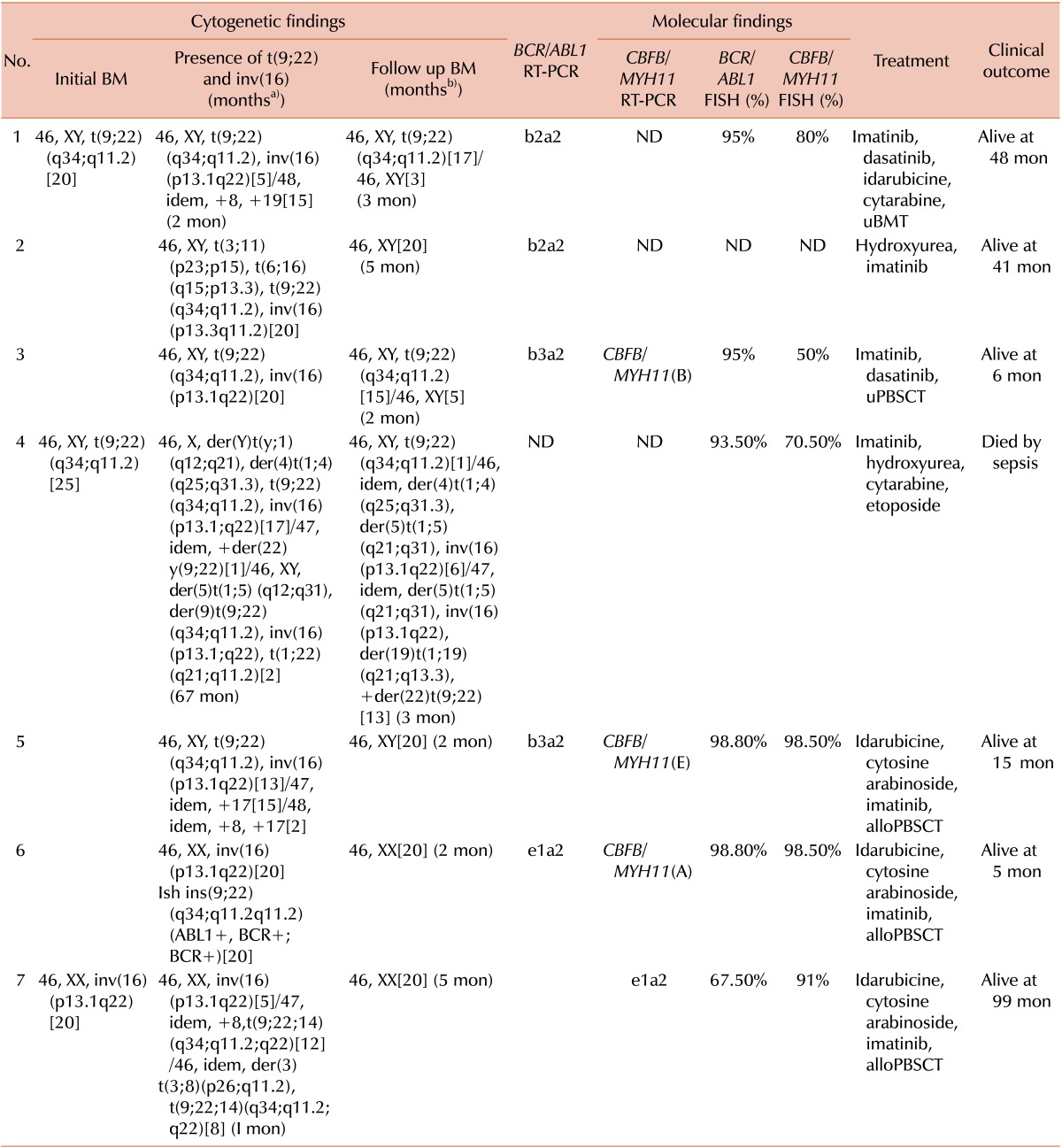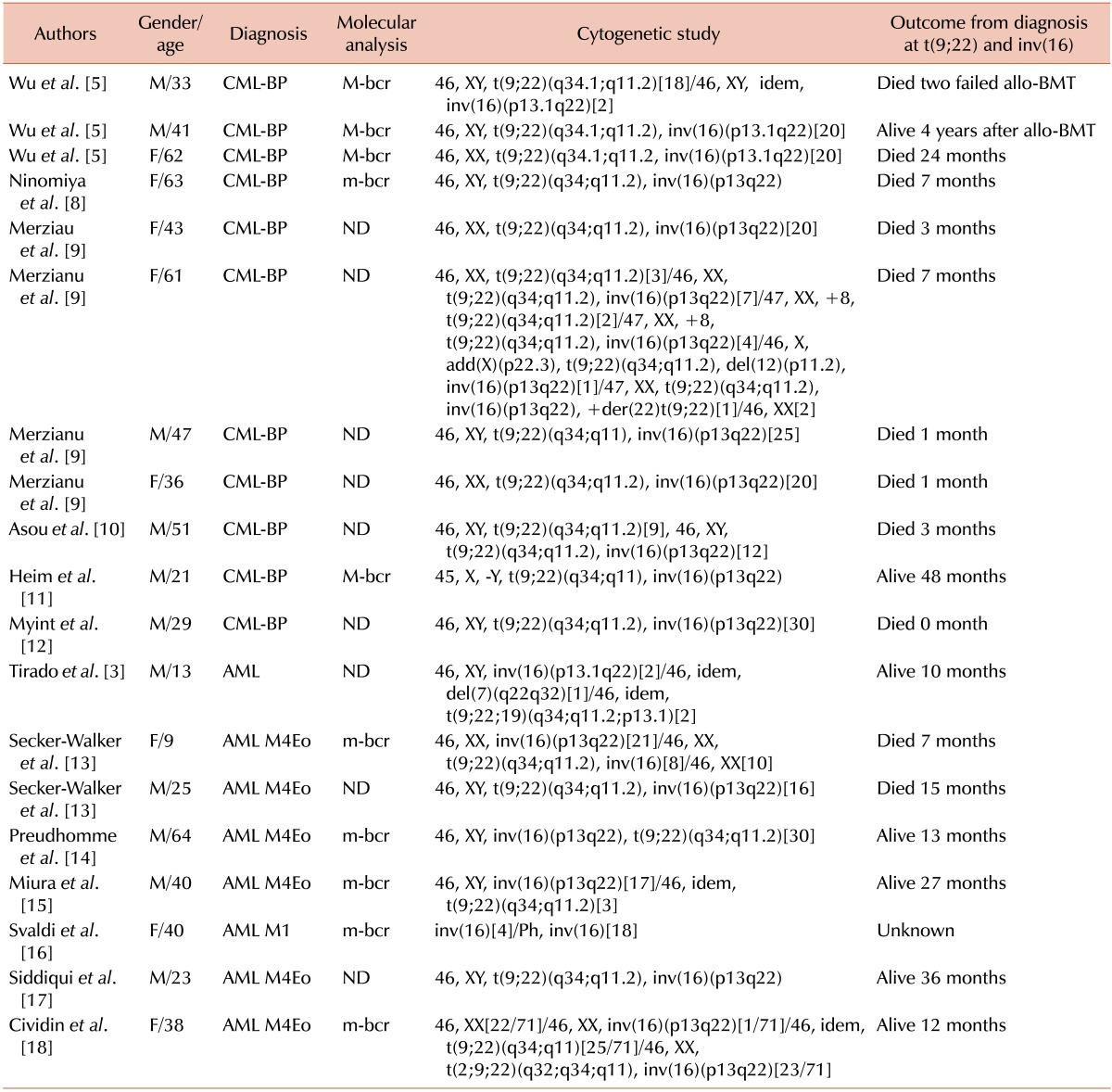1. Swerdlow SH, Campo E, Harris NL, editors. WHO classification of tumours of haematopoietic and lymphoid tissues. 4th ed. Lyon, France: IARC;2008.
2. Patel BB, Mohamed AN, Schiffer CA. "Acute myelogenous leukemia like" translocations in CML blast crisis: two new cases of inv(16)/t(16;16) and a review of the literature. Leuk Res. 2006; 30:225–232. PMID:
16076492.

3. Tirado CA, Valdez F, Klesse L, et al. Acute myeloid leukemia with inv(16) with CBFB-MYH11, 3'CBFB deletion, variant t(9;22) with BCR-ABL1, and del(7)(q22q32) in a pediatric patient: case report and literature review. Cancer Genet Cytogenet. 2010; 200:54–59. PMID:
20513535.

4. Roth CG, Contis L, Gupta S, Agha M, Safyan E. De novo acute myeloid leukemia with Philadelphia chromosome (BCR-ABL) and inversion 16 (CBFB-MYH11): report of two cases and review of the literature. Leuk Lymphoma. 2011; 52:531–535. PMID:
21281226.
5. Wu Y, Slovak ML, Snyder DS, Arber DA. Coexistence of inversion 16 and the Philadelphia chromosome in acute and chronic myeloid leukemias: report of six cases and review of literature. Am J Clin Pathol. 2006; 125:260–266. PMID:
16393682.
6. Kim M, Lim J, Kim Y, et al. A case of therapy-related acute myeloid leukemia associated with inv(16), with subsequent development of t(9;22). Leukemia. 2006; 20:746–748. PMID:
16437154.

7. Willatt L, Morgan S, Shaffer LG, Slovak ML, Campbell LJ. ISCN 2009 an international system for human cytogenetic nomenclature. Hum Genet. 2009; 126:603–604.
8. Ninomiya S, Kanemura N, Tsurumi H, et al. Coexistence of inversion 16 and the Philadelphia chromosome comprising P190 BCR/ABL in chronic myeloid leukemia blast crisis. Int J Hematol. 2011; 93:806–810. PMID:
21523337.

9. Merzianu M, Medeiros LJ, Cortes J, et al. inv(16)(p13q22) in chronic myelogenous leukemia in blast phase: a clinicopathologic, cytogenetic, and molecular study of five cases. Am J Clin Pathol. 2005; 124:807–814. PMID:
16203287.
10. Asou N, Sanada I, Tanaka K, et al. Inversion of chromosome 16 and bone marrow eosinophilia in a myelomonocytic transformation of chronic myeloid leukemia. Cancer Genet Cytogenet. 1992; 61:197–200. PMID:
1638503.

11. Heim S, Christensen BE, Fioretos T, Sorensen AG, Pedersen NT. Acute myelomonocytic leukemia with inv(16)(p13q22) complicating Philadelphia chromosome positive chronic myeloid leukemia. Cancer Genet Cytogenet. 1992; 59:35–38. PMID:
1555189.

12. Myint H, Ross FM, Hall JL, Hamblin TJ. Early transformation to acute myeloblastic leukaemia with the acquisition of inv(16) in Ph positive chronic granulocytic leukaemia. Leuk Res. 1997; 21:473–474. PMID:
9225078.

13. Secker-Walker LM, Morgan GJ, Min T, et al. Inversion of chromosome 16 with the Philadelphia chromosome in acute myelomonocytic leukemia with eosinophilia. Report of two cases. Cancer Genet Cytogenet. 1992; 58:29–34. PMID:
1728947.
14. Preudhomme C, Lai JL, Plantier I, Demory JL, Zandecki M, Fenaux P. Cytogenetic and molecular remission in a case of acute myeloid leukaemia(AML) with inversion of chromosome 16 (Inv(16)) and Philadelphia chromosome (Ph). Br J Haematol. 1992; 82:623–626. PMID:
1486046.
15. Miura I, Takatsu H, Yamaguchi A, et al. Standard Ph chromosome, t(9;22)(q34;q11), as an additional change in a patient with acute myelomonocytic leukemia (M4Eo) associated with inv(16)(p13q22). Am J Hematol. 1994; 45:94–96. PMID:
8250017.

16. Svaldi M, Lanthaler A, Venturi R, Coser P, Mitterer M. Simultaneous occurrence of bcr-abl and inv16 in a case of M1 acute myeloid leukemia. Leukemia. 2001; 15:695. PMID:
11368385.

17. Siddiqui AD, Sheikh ZS, Liu D, Seiter K. Coexistence of inversion 16 and the Philadelphia chromosome in patients with acute myelogenous leukemia. Leuk Lymphoma. 2002; 43:1137–1140. PMID:
12148898.

18. Cividin M, Brizard F, Sorel N, Renaud M, Guilhot F, Brizard A. p190(BCR-ABL) rearrangement as a secondary change in a case of acute myelo-monocytic leukemia with inv(16)(p13q22). Leuk Res. 2004; 28:97–99. PMID:
14630086.

19. Bacher U, Haferlach T, Alpermann T, et al. Subclones with the t(9;22)/BCR-ABL1 rearrangement occur in AML and seem to cooperate with distinct genetic alterations. Br J Haematol. 2011; 152:713–720. PMID:
21275954.

20. Malagola M, Breccia M, Skert C, et al. Long term outcome of Ph+ CML patients achieving complete cytogenetic remission with interferon based therapy moving from interferon to imatinib era. Am J Hematol. 2014; 89:119–124. PMID:
24122886.

21. Dai HP, Xue YQ, Wu LL, et al. p210 BCR/ABL1 as a secondary change in a patient with acute myelomonocytic leukemia (M4Eo) with inv(16). Int J Hematol. 2012; 96:814–817. PMID:
23054652.
22. Bustamante D, Chan KR, Czuchlewski DR, Saadi AA. Patterns of BCR breakpoints in patients with coexisting inv(16) (p13.1q22) and t(9;22)(q34;q11.2). Int J Hematol. 2012; 95:324–326. PMID:
22370710.
23. Schnittger S, Bacher U, Haferlach C, Kern W, Haferlach T. Rare CBFB-MYH11 fusion transcripts in AML with inv(16)/t(16;16) are associated with therapy-related AML M4eo, atypical cytomorphology, atypical immunophenotype, atypical additional chromosomal rearrangements and low white blood cell count: a study on 162 patients. Leukemia. 2007; 21:725–731. PMID:
17287858.

24. Nacheva EP, Grace CD, Brazma D, et al. Does BCR/ABL1 positive acute myeloid leukaemia exist? Br J Haematol. 2013; 161:541–550. PMID:
23521501.
25. Goyama S, Mulloy JC. Molecular pathogenesis of core binding factor leukemia: current knowledge and future prospects. Int J Hematol. 2011; 94:126–133. PMID:
21537931.

26. Rucker FG, Schlenk RF, Bullinger L, et al. TP53 alterations in acute myeloid leukemia with complex karyotype correlate with specific copy number alterations, monosomal karyotype, and dismal outcome. Blood. 2012; 119:2114–2121. PMID:
22186996.
27. Palandri F, Castagnetti F, Testoni N, et al. Chronic myeloid leukemia in blast crisis treated with imatinib 600 mg: outcome of the patients alive after a 6-year follow-up. Haematologica. 2008; 93:1792–1796. PMID:
18838477.

28. Sun J, Wang Z, Luo Y, Tan Y, Allan DS, Huang H. Prolonged survival with imatinib mesylate combined with chemotherapy and allogeneic stem cell transplantation in de novo Ph+ acute myeloid leukemia. Acta Haematol. 2012; 127:143–148. PMID:
22248505.

29. Andersen MK, Larson RA, Mauritzson N, Schnittger S, Jhanwar SC, Pedersen-Bjergaard J. Balanced chromosome abnormalities inv(16) and t(15;17) in therapy-related myelodysplastic syndromes and acute leukemia: report from an International Workshop. Genes Chromosomes Cancer. 2002; 33:395–400. PMID:
11921273.

30. Park SH, Chi HS, Cho YU, Jang S, Park CJ. Evaluation of prognostic factors in patients with therapy-related acute myeloid leukemia. Blood Res. 2013; 48:185–192. PMID:
24086938.








 PDF
PDF ePub
ePub Citation
Citation Print
Print


 XML Download
XML Download